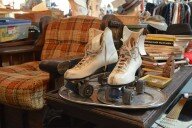I’ve been to a few art museums in my time. The ones I’ve visited were filled with oil paintings and photography or ancient African tribal masks. If you told me the next time museum I’d visit would have on display 3-dimensional fluorescent art, I probably wouldn’t believe it.
Located at 25310 Newberry Road, America’s First 3-D Fluorescent Art Museum, established by artist Robert Roberg and his wife, is a small gallery consisting of two rooms, each displaying works by various artists. The museum stands out on the dusty, gray road it’s on with its bright sign.
I arrived early Saturday afternoon before it opened to talk to Roberg. Things were still being set up, but I was generously allowed inside to explore.
There are eight artists being shown in the exhibit, Roberg said, three of which are from foreign countries South Korea, Germany and Latvia. Roberg’s work is also on display.

Via: facebook.com/3DFluorescenArtMuseum
The art was bright and colorful when I first walked in, but I was handed a pair of paper 3D glasses by Roberg, who then turned off the lights, in order to get the full effect.
The room did more than just come to life. Not only were the colors vivid, but the images moved when you moved and had quite some depth. In fact, it seemed as if you could reach into the very heart of some of the paintings and take out images from inside of them.
Coming to an idea like this took some time, as I came to find out after talking to Roberg.
“We all start as little kids,” Roberg said.
It was while in the Peace Corps in Peru that Roberg really got started painting.
“We did a lot of world traveling and painted as we went,” Roberg said of he and his wife.
In 1988, Roberg started painting with fluorescents. 
“I felt like this was a step forward in the world of art,” Roberg said.
He believed he could go even further in the world of 3D, but there wasn’t a legitimate area to display it…until now. At the grand opening on Friday night, Roberg was presented with a picture drawn by his daughter of her design for his art gallery. Now in her 30s, she drew the picture in pen when she was around 11.
“I must have been talking about it for 20 years,” Roberg said.
Now the museum is up and running, showing work from around the world, and each piece has a story. All of the art is for sale, and every artist is different from the next.
Christine Claringbold of Portland, Ore. painted on old records that actually spins in the display, making a sort of illusion when you wear the 3D glasses.
A painting of a young woman by Buyeon Kwan of South Korea was one of Kwan’s first. Coached by Roberg herself, her work looks like it has a felt-like texture.
One of Roberg’s pieces in the second room, created during a time when he was heavily interested in the idea of an apocalypse, boasted characters that appeared to be floating in the stars.
The museum is also a great place for family events. They have workshops set up for Saturdays and even open-mic nights on some Sundays.
With a 1-year lease on the building, Roberg hopes to continue showing his art and the art of others for quite a while. The museum is open every Friday night from 7 p.m. to 9:30 p.m. and every Saturday 4 p.m. to 8 p.m.
Whether you’re a self-proclaimed art connoisseur or simply looking to mix up your weekend, pay a visit to America’s First 3-D Fluorescent Art Museum. It’s guaranteed to light up your world.






